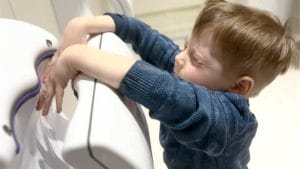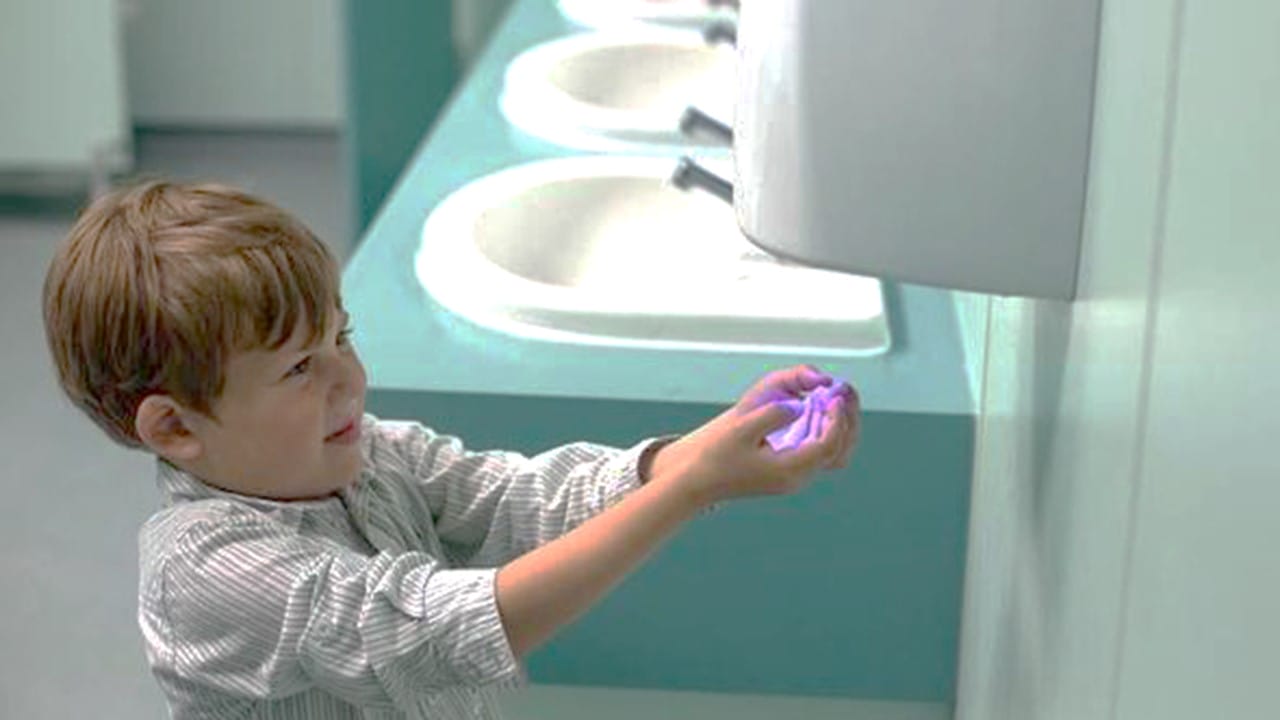Table of Contents
There is a lot of debate over whether or not air hand dryers in public restrooms are really safe to use. Some people argue that because the machines use high-speed airflow, they can spread bacteria around more quickly than traditional hand dryers. Others say that the machines are actually less likely to spread bacteria than conventional hand dryers, as the airflow focuses on specific areas of the hands rather than being dispersed throughout the room. Ultimately, it seems safest to avoid using hand dryers in public restrooms if possible, and instead, use traditional methods like paper towels.
What is Proper Hand Sanitation?
We were taught to wash our hands properly by singing happy birthday three times during the global pandemic. So here is the step-by-step process and the proper way to wash your hands according to various health government sites and medical hospitals:
- Handwashing with soap and water
- Do it in 20 seconds (or sing happy birthday three times while washing your hands)
- Wash the front, back, and side of the hands.
- Clean each finger and nails.
- Rinse thoroughly with water
- Close the water tap
It is an easy step, but what about drying our hands?
It is also essential to discuss how to dry your hands in public toilets.
What is an Air Hand Dryer and How It Works?
An air hand dryer is a small, portable device that uses compressed air to dry your hands. They are often placed in public restrooms to help dry wet hands.
A hand dryer is a straightforward machine that uses air to heat up and evaporate water from the hands.
Why Do People Use the Air Hand Dryer
Well, for obvious reasons, it is available in public restrooms, located just beside the water tap. So naturally, people will use them.
People use the air hand dryer for a variety of reasons. Most people use hand dryers because they can easily find them beside the water tap, and they are more convenient than using a towel. Others may find that the air hand dryer dries their hands faster than using a towel. In some cases, people may use the air hand dryer because they are worried about spreading bacteria to other surfaces if they use a towel.
Are There Any Studies and Proofs On Why Hand Dryers Spreading Bacteria?
There are several studies from infectious disease experts, medical societies, medical universities, and journals. For example, according to the Journal of Hospital Infection, air bacterial counts in close proximity to hand-drying by a jet air dryer were 27-fold higher than measured next to use of paper towels (P < 0.001). Here are some of the studies that prove air hand dryers emits more bacteria:
- Harvard University Health
- PubMed Saudi Journal of Biological Sciences
- PubMed
- Applied and Environmental Microbiology
- American Society for Microbiology
- The Journal of Hospital Infection
- Society for Applied Microbiology
So How Do Air Hand Dryers in Public Restrooms Spread Bacteria?
Hand dryers are often available in various public restrooms, which can result in the spread of bacteria. This is because hand dryers produce high levels of heat and humidity, which can allow bacteria to grow more quickly. Public restrooms are often places where people congregate, which can lead to contact with bacteria.
Public toilets are commonplace for people to spread bacteria, and hand dryers are one of the most common ways bacteria spread throughout public toilets. Hand dryers use air compression to dry your hands, which can cause bacteria to be blown all over the bathroom. When you use a hand dryer in a public restroom, you’re putting yourself and other people in that bathroom at risk of getting sick from the bacteria.
What Kind of Bacteria Do Hand Dryers Spread in Public Toilets?
According to multiple medical studies, these are the bacteria found in public bathroom hand dryers:
Coliforms bacteria
There are many types of bacteria, but two that are most commonly associated with health concerns are fecal coliforms and E. coli. Fecal coliforms are bacteria found in the intestinal tracts of humans and other animals. They can be a sign of poor sanitation, which can lead to food poisoning. E. coli is a type of bacteria that is common in the gut of animals and can cause serious illness if it enters the body through contaminated food or water.
Staphylococcus haemolyticus
Staphylococcus haemolyticus is a type of bacteria that can cause a severe infection in the body. It can spread through contact with blood, saliva, or mucus and can cause severe illness in people of all ages. Hand dryers in toilets can spread staphylococcus haemolyticus bacteria, which is why it’s essential to keep them clean.
Staphylococcus aureus
Staphylococcus aureus is a type of bacteria that can cause infections, including pneumonia and skin infections. It is most commonly found on the skin or the nose but can also be found in the throat, ears, and urinary tract. Staphylococcus aureus is resistant to many antibiotics, so it is crucial to get treatment as soon as possible if you are infected with it.
Micrococcus luteus
Micrococcus luteus is a type of bacteria that is commonly found in the human gut. It is believed to play a role in the development of various diseases, including Crohn’s disease and ulcerative colitis. Hand dryers are known to spread micrococcus luteus, which can lead to these diseases.
Pseudomonas alcaligenes
Pseudomonas Alcaligenes is a Gram-negative bacterium that can cause serious infections in humans. It is commonly found in water and soil and can spread through contact with contaminated surfaces or respiratory secretions. Hand dryers are one common way that this bacteria is spread, as they often leave moist hands and surfaces near them free to contaminate other areas. P. Alcaligenes can cause a wide variety of illnesses, including pneumonia, urinary tract infections, and bloodstream infections.
Bacillus cereus
Bacillus cereus is a bacterium that can cause food poisoning. It is most commonly found in raw meat and unpasteurized milk and juices. Symptoms of food poisoning caused by Bacillus cereus include nausea, vomiting, and diarrhea. In severe cases, the bacteria can also cause skin lesions, pneumonia, and even death.
Bacillus subtilis strain
Bacillus subtilis is a bacterium that can cause skin and respiratory infections. It is most commonly found in soil and water but can also spread through contact with contaminant surfaces. A strain of Bacillus subtilis known as ST131 is particularly dangerous because it can cause food poisoning.
Brevundimonad diminuta/vesicularis
Brevundimonad Diminuta/Vesicularis is a bacterium that can cause hand-drying to spread bacteria more easily in toilets. It can also cause urinary tract infections (UTIs).
S. haemolyticus
Pathogen S. Haemolyticus is a bacterium that can cause serious infections in humans. It is found in the environment and can spread through contact with respiratory secretions, such as saliva or mucus, from a person with an infection. Pathogen S. Haemolyticus can also be spread through contact with contaminated objects, such as doorknobs or countertops. Symptoms of infection include fever, chills, and a severe headache. The infection can lead to blood poisoning and even death in some cases.
Acinetobacter
Acinetobacter is a type of bacteria that can cause serious infections in humans. Acinetobacter bacteria can cause serious infections, such as pneumonia, bloodstream infections, and urinary tract infections. Acinetobacter bacteria are also responsible for a number of foodborne illnesses, including listeriosis and E. coli poisoning.
Paper Towel vs. Hand Dryers
Paper towels are often seen as the safer option when it comes to hand drying, as they do not spread bacteria around as hand dryers can. However, a study in the journal “Environmental Science and Technology” found that paper towel use actually increases the spread of bacteria in public restrooms. Researchers found that bacteria levels decrease by 80% when people use paper towels than hand dryers. However, when using paper towels without a hand dryer, levels of bacteria increase by 200%.
According to WebMD’s article, bacteria are also in unused paper towels. This study is the result of research by medical journal study.
Do I use a paper towel or hand dryers? Who should I believe then?
Well, this really boils down to who gave the funding? What’s the angle in creating the research?
On the other hand, Vox magazine said that Big Tissue companies are funding the research to destroy the image of hand dryer manufacturers.
Alternative for Air Drying Hands in a Public Washroom to Avoid Bacteria
There is a growing concern that hand dryers in public restrooms are spreading bacteria. Many people believe that it is more hygienic to avoid the spread of bacteria by drying hands using an alternative method, such as air drying. Some people have even gone so far as to advocate for the removal of hand dryers from public restrooms altogether in order to avoid the spread of bacteria.
Here is a definitive answer, bring your own paper towel.
If you need to dry your hands in a public restroom, a few alternatives are available.
- Bring your own paper towel when going to the public comfort room
- When you go out of the public bathroom, spray a sanitizer or alcohol on your hands.
- Use wet wipes with alcohol after using the public washroom
Conclusion: Hand Dryers in Public Restrooms
Many studies from health journals, medical universities, and microbiology organizations show that hand dryers in public restrooms spread more bacteria than traditional paper towels. Researchers found that the use of hand dryers can increase the amount of bacteria on hands by up to 700%. This increase could lead to skin infections, respiratory problems, and even food poisoning. Various healthcare professionals in several medical and technology journals did the medical research.














